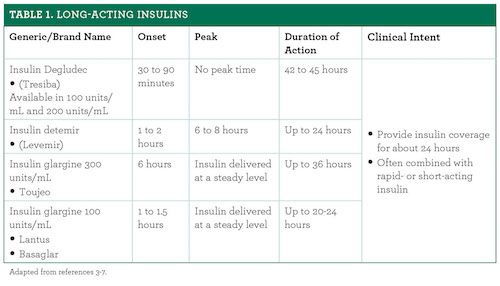Publication
Article
Pharmacy Times
Long-Acting Insulins Useful Tools in Type 1 and Type 2 Diabetes
Author(s):
Researchers have augmented insulin’s effectiveness with several rapid and long-acting analogs and new delivery systems, such as insulin pens and insulin pumps.
Researchers have augmented insulin's effectiveness with several rapid and long-acting analogues and new delivery systems such as insulin pens and insulin pumps. Biosynthetic preparations with various pharmacokinetic profiles somewhat mimic the steady insulin release from a normal pancreas. Long-acting insulins create unprecedented prescribing flexibility, as prescribers can tailor patients' regimens to their individual activity levels, eating habits, and responses to insuli
Insulin is a necessity for patients who have type 1 diabetes (T1D). For many people who have type 2 diabetes (T2D), insulin can improve glycemic control significantly. Still, many clinicians are reluctant to initiate injectable glucose-lowering therapies in T2D. They often perceive, rationally or irrationally, that patients will have difficulty understanding complex regimens. Many clinicians also report that they are less proficient than they would like with insulin, creating discomfort with diabetes management.1 And they perceive that multidose insulin regimens may be associated with increased episodes of hypoglycemia, though they are not.2 However, today's long-acting insulins such as insulin detemir, insulin glargine (IGlar), and insulin degludec (IDeg) offer convenience that increases adherence significantly (Table 13-7). They also tend to have fewer adverse effects, which can simplify patients' regimens and improve control.3-7

Designing a Regimen
For most patients, designing an optimal insulin regimen is a continuing process that may require formulation changes, dose-related fine tuning, and introduction of insulin or multiple insulin products when patients cannot meet glycated hemoglobin (HbA1c) goals by other means.
The long-acting insulin products have advantages and disadvantages. Each offers once-daily dosing. IDeg's ultralong duration of action might allow flexibility in dosing times but not longer intervals between scheduled doses. IDeg is indicated as a once-daily insulin, but its long duration of action may be advantageous in nonadherent patients because coverage continues if they miss one dose.8
In T1D patients, insulin detemir must be used with rapid- or short-acting insulin.5 Although IGlar-100 and insulin detemir can be dosed once daily, patients who experience hyperglycemia close to the time that the next dose is scheduled may need twice-daily dosing.4-7
Highly concentrated, IGlar-300 may be advantageous for patients who take large doses of insulin, as it requires a smaller volume and sometimes, a smaller number of injections. One clinical trial demonstrated that IGlar-300 is associated with less weight gain. However, patients required about 10% more insulin when using IGlar-300, compared with IGlar-100.7 Clinical trials excluded patients with renal or hepatic dysfunction, so prescribers will need to monitor carefully when prescribing either product in patients with organ dysfunction.3-7
Changes in insulin strength, manufacturer, type, or method of administration may precipitate a need to change the insulin dose or an adjustment of concomitant antidiabetic treatment. Clinicians often find conversion between insulin formulations somewhat complicated, but it doesn't need to be (Table 23-7,9).3,6,7

Ms. Wick is a visiting professor at the University of Connecticut School of Pharmacy.
References
- Polinski JM, Smith BF, Curtis BH, et al. Barriers to insulin progression among patients with type 2 diabetes: a systematic review. Diabetes Educ. 2013;39:53-65.
- Qiu Y, Li Q, Tang J, et al. Why physicians do not initiate dual therapy as recommended by AACE guidelines: A survey of clinicians in the United States. Diabetes Res Clin Pract. 2015;108:456-465.
- Tresiba [insulin degludec injection package insert]. Plainsboro, NJ: Novo Nordisk; 2016.
- Levemir [insulin detemir injection package insert]. Plainsboro, NJ: Novo Nordisk; 2015.
- Basaglar [insulin glargine injection package insert]. Indianapolis, IN: Lilly USA, LLC; 2015.
- Lantus [insulin glargine injection package insert]. Bridgewater, NJ: sanofi-aventis LLC; 2015.
- Toujeo [insulin glargine injection package insert]. Bridgewater, NJ: sanofi-aventis LLC; 2015.
- Miller E, Costello J. Overcoming patient barriers in glycemic control: clinical advances in combination glp-1 and insulin therapy. Pharmacy Times. 2016. Available at http://www.pharmacytimes.com/publications/issue/2016/june2016/overcoming-patient-barriers-in-glycemic-control-clinical-advances-in-combination-glp-1-and-insulin-therapy. Accessed July 13, 2017.
- Henry RR, Bailey TS, Lane WS, Peters AL. Concentrated insulin: Deciphering the when and the how for better patient outcomes. June, 2016. Available at http://www.medscape.org/viewarticle/864356_transcript. Accessed July 13, 2017.
- Niswender, K. Early and aggressive initiation of insulin therapy for type 2 diabetes: What is the evidence? Clinical Diabetes. 2009;27(2):60-68.
- Kubus C, Wick JY. Drug-device combinations: are they appropriate for the aging population? Consult Pharm. 2016 May;31(5):240-250.
- Garber AJ, Abrahamson MJ, Barzilay JI, et al. Consensus statement by the American Association of Clinical Endocrinologists and American College of Endocrinology on the comprehensive type 2 diabetes management algorithm - 2016 executive summary. Endocr Pract. 2016;22:84-113.
- American Association of Clinical Endocrinologists. AACE/ACE Comprehensive Type 2 Diabetes Management Algorithm 2016. Available at https://www.aace.com/publications/algorithm. Accessed July 13, 2017.
- Accurate Insulin Decisions. Managing your diabetes with mealtime insulin. Available at http://www.accurateinsulin.org/. Accessed July 13, 2017.
- Prescrire Editorial Staff. Insulin use: preventable errors. Prescrire Int. 2014;23(145):14-17.
- Guo H, Fang C, Huang Y, et al. The efficacy and safety of DPP4 inhibitors in patients with type 1 diabetes: A systematic review and meta-analysis. Diabetes Res Clin Pract. 2016;121:184-191.
- Bode BW, Garg SK. The emerging role of adjunctive noninsulin antihyperglycemic therapy in the management of type 1 diabetes. Endocr Pract. 2016;22(2):220-230.







